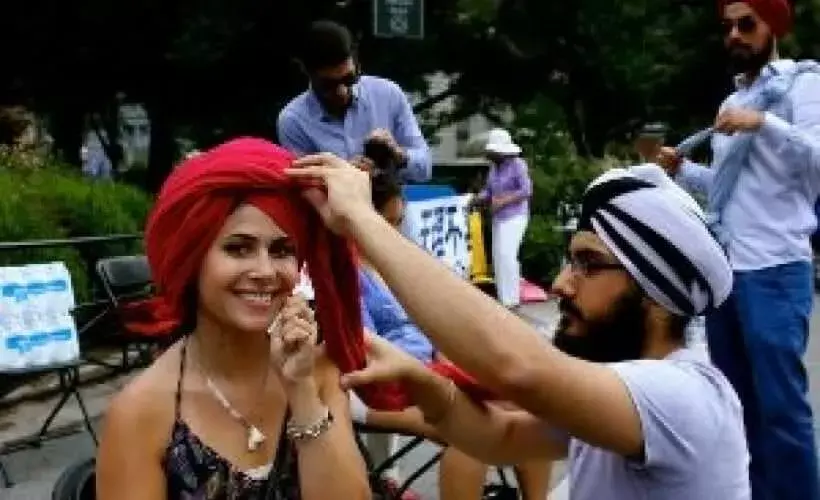Head Turners All!
From turbans, caps, to scarves headdresses are diverse and charming

A ‘Spiderman’ with a red turban in Times Square doing the moves was a head turning sight recently. One saw a robust rallying together of Sikh diaspora to celebrate Turban Day, a colourful aggregation of people of all ages.
Women too joined in this event with panache and tied pagdis matching with their outfits. All this with bhangra rap being played, it could’ve been mistaken for a scene from the Aishwarya Rai movie, ‘Balle Balle! Amritsar to L.A’.
But the sub-text for this festive event was to make Americans realise the fact that Sikhism mandates wearing a turban for men over their tied up hair as part of their core religious tenets. Some Sikh women too have adopted turban wearing but they mostly cover their heads with a ‘chunni’.
Post 9/11 the more insular Yanks equated the turban with Islamist terrorists, sadly leading to many innocent Sikhs being killed and their shops vandalised. The bigotry and ignorance displayed in these bizarre incidents brings to mind the famous political novel, ‘The Ugly American’ (1958)written by William Lederer and Eugene Burdick.
They expressed their disillusionment at the utter lack of cultural understanding of Southeast Asia by smug Americans, just when the Vietnam war drum beats were sounding louder.
Interestingly, Bharatvarsh and America are currently in a loving clinch diplomatically (jhappi pappi) at the highest level. There is a constant iteration of being BFFs (best friends forever).
Narendra Modi’s state visit to the United States in June should generate a rich harvest of hugs. So we hope more Americans can wrap their heads around the nuances of turbans and other headgear!
Saafas, Dastars, Pagris, or simply the turban extends its reach from the Indian subcontinent, the Arabian Peninsula, West Africa, North Africa, East Africa, and Balkans. It sits on the heads of colourful folk in Central Asia, the Caucasus and South East Asia and some more.
The semiotics of the turban are not religious alone but ethnic, martial, and simply functional. It is gender neutral, a class indicator and has obvious functionality as a protector from extreme heat, cold or danger.
The women In Africa have traditionally worn flamboyant headdresses. That intriguing wrapping of cloth on the head can be used as a billboard displaying info about their marital, social and economic status. But the men wear a simple brimless round cap called Kufi or Tupi, familiar to us as Topi.
The women in Europe added a fashion dimension to the headdress and wore all manner of high Crown Hats, Pillboxes, Toques etc. The ‘upper class’ ladies wore hats with pheasant or peacock feathers whereas the commoners could wear cheaper goose, duck or grouse feathers, without a grouse, of course!
Indian head dresses for both genders are amazingly diverse and charming. A unique headdress worn by Kashmiri Hindu women only as a bridal custom now is the intricately layered ‘Taranga’. Whether apocryphal or a fact, it is said that this was bestowed as a reward on a Brahmin woman by Adi Shankaracharya for showing her depth of knowledge on the Shakti doctrine during his visit to Kashmir in the 9th Century.
Since the 1990s the fascinator, purely an ornamental piece attached to a band, has been the chosen headwear turning heads at special events like Royal weddings, Royal Ascot and other premium horse-racing venues and garden parties in the West.
The ladies are milling around the milliners to design an eye-catching fascinator for them, and hats-off to the innovative designers to pass this demanding test, at a steep price of course.
There is a bonanza of professional or niche hats from Chefs, Berets, Helmuts, Mortar Caps, Beanies and the youth with the universal back to front baseball cap to name a few.
Some global leaders have become synonymous with their headwear. Nehru wore his topi, Hamid Karzai from Afghanistan always wore his Karakul cap, our own Sheikh Abdullah wore it and his scion Farooq Abdullah wears the same with great elan.
The iconic Palestinian political leader Yasser Arafat in his signature Palestinian Keffiyeh, a chequered black and white scarf headdress, is considered the symbol of Palestinian nationalism. Admiral Nelson died in harness in the famous Battle of Trafalgar wearing a two cornered Admiral’s hat on the quarter deck of his ship, Victory, and Napoleon Bonaparte, on the losing side, is always imaged wearing a similar bicorn hat.
We can not strut on stage without mentioning our furry friends. Some legendary cartoon characters, much loved by the young and the old , can also throw their hats into the ring. ‘The Cat in the Hat’ by Dr. Seuss and the Mad Hatter from ‘Alice in Wonderland’ amongst others can surely nudge us off centrestage easily!



